Santorini's white wines and Vinsanto are among the best wines in Greece today. But the ongoing tourism boom on the beautiful crater island is taking its toll: water is becoming scarce, the vineyards have been shrinking for years - and in the remaining vineyards there are only extremely low yields with a hard struggle against wind and drought.
Advertising:
The most beautiful first encounter with the Santoríni archipelago and its world-famous main crater island of Thíra is for the visitor who slowly sails on a ship into the caldera, the magically attractive collapse cauldron of the gigantic volcanic eruption around 1645 BC. In addition to Mediterranean dreamy and touristy villages, a ruined city over 3500 years old, whitewashed houses and small chapels with their blue domes, the view of up to 300 metres high, reddish-black crater walls, which continue just as deep into the water-filled caldera, is particularly fascinating. Of the island once known as "Strongyle" - the "Round" - what remained after the great eruption was a crescent-shaped island arc only 16.4 kilometres long and between 1.3 and six kilometres wide: What it once lost in substance, the island gained in fragile beauty.Today's tourist magnet - formerly called Kallistí, the most beautiful of the Cyclades - also has a unique wine culture, however. It finds its archaic image in a form of vine training that has nothing to do with the usual European order of vineyards: The vines duck into the soil of the plateaus between lava boulders like scattered birds' nests to protect themselves from wind and weather. Their branches are twisted in a circle after the annual spring pruning; the resulting shape of the bushy vines is reminiscent of baskets, wreaths or large, twisted curls - "kouloura.
|
|
Publicity:
In terms of wine law, Santorini has been one of the 28 Greek appellations for quality wine since 1971, officially called "Onomasía Proeléfseos Anotéras Piótitos" (Appellation of Origin of Higher Quality - OPAP). They are also often called AOC (Appellation d'Origine Contrôlée) wines, following the French wine law that was used as a model at the time. The OPAP classification on Santorini is reserved exclusively for the autochthonous white varieties Assyrtiko, Aidani Aspro and Athiri. Assyrtiko must contain at least 75% for classification; the combined share of Aidani Aspro and Athiri must not exceed 25%. This regulation applies to both the dry white wines
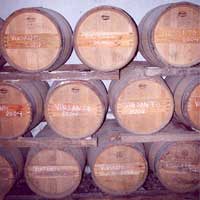 |
| 2004 Vinsanto - a good vintage |
as well as for the Vinsanto.
. As a rule, most winemakers use only Assyrtiko and Aidani for Vinsanto, but there are also versions with all three grape varieties. For the dry white wine Santorini OPAP, the majority of wineries use only Assyrtiko, but there are still winemakers who combine all three grape varieties into a cuvée. Today, white wine varieties make up 80% of the vine population on the island, of which the expressive white Assyrtiko again has a share of 90%. Among the red varieties, it is mainly Mandilaria and Mavrotragano that are now being used to produce remarkable red wines. Grown in the rather temperate climate of warm, dry summers and mild winters, nourished by volcanic soil, sea air and sea water, Santorini's white wines in particular present themselves as classic, elegant terroir wines. With sometimes salty notes, firm structure, often earthy aromas and minerality, typical citrus aromas and extremely dry acidity profiles paired with delicate fruitiness, they are considered very good food companions - and enhance Santorini's reputation as one of the best Greek appellations.|
Low yields, high acidity, sweet Vinsanto: For red table wines (Epitrapezios Oinos) and land wines (Topikos Oinos), yields range from 19 to 40 hl/ha, depending on the quality of the land. In the case of OPAP grapes, yields also vary greatly - and at a low level: 15 - 28 hl/ha. Alcohol levels here are mostly between 12.5 and 14%, with the majority of wines having 13% or more. |
 |
| Assyrtiko vines in the traditional vineyard Kouloura |
Nine wineries, including the four oldest on the island, now belong to OPAP Santorini.
There are good reasons to start the discovery tour with the Koutsoyiannopoulos Winery.
, the oldest OPAP winery - after all, it offers the great advantage of literally being able to dive deep into the history of Santorini's wine culture with a good wine in your glass. The owner, George Koutsoyiannopoulos, is happy to personally guide visitors through the wine museum he has lovingly put together in great detail in the cellar of his winery in Vothonas (centre of the island, near the airport), which was founded in 1870 and documents Santorini's wine history from 1660 to 1970. George Koutsoyiannopoulos, however, is not only an enthusiastic storyteller, but also an excellent winemaker. In Santorini's modern parade discipline, the strong, dry Assyrtiko, Koutsoyiannopoulos knows how to convince with his extremely refreshing "Santorini", which exudes citrus and pineapple notes. The "Nykteri" (night), also aged in wooden barrels and made from fully ripe Assyrtiko grapes, is even more concentrated and deeper. It is only surpassed by the house's 50-year-old Vinsanto: tasting it makes it understandable why tsars, Russian monasteries and Venetian nobility used to be enthusiastic about this nectar-like drink.
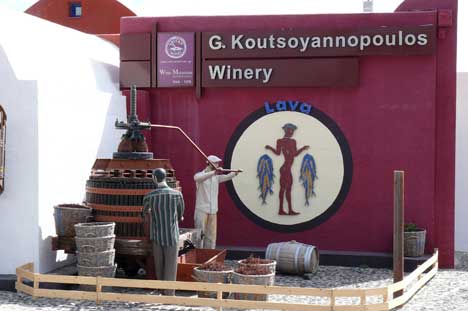 |
| Koutsoyiannopoulos - winery and wine museum |
Haridimos and Konstantina Hatzidakis have been working on their own small estate on a 300-metre-high site near Pyrgos in the south of the island since 1997. The former Boutari oenologist Hatzidakis is convinced that the Santorini wine region still "holds many secrets to be uncovered". To this end, a cave (canava.
) used by Konstantina's grandfather as a tool shed and cowshed was first converted into a winery, which is now used to produce a wide range of white wines, but also the autochthonous red wine variety Mavrotragano, reserved for Santorini.
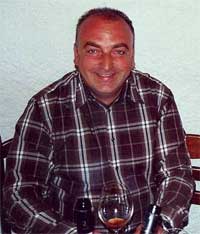 |
| Haridimos Hatzidakis |
Hatzidakis also practices the somewhat higher, cup-shaped Buscherziehung "Gobelet" for the Assyrtiko vine on a small area, which is, however, somewhat more susceptible to wind breakage. "But it produces higher grape quality," Haridimos Hatzidakis is convinced. The yields are between 35 and 40 hl/ha - clearly above-average quantities for Santorini. A spontaneously fermented cuvée of 90% Assyrtiko and 10% Aidani Aspro is powerful with a pronounced minerality, and with the Mavrotragano 2006, Hatzidakis is one of the first bottlers of red wines on Santorini to have succeeded in creating a highly aromatic example of modern red wine style, matured in new barrique barrels.
|
From wine boom to tourist boom, from vineyards to hotel beds: The foundation was laid early: The Phoenicians are said to have brought wine with them from Assyria, where Assyrtiko is thought to have originated. But it was not until Venetian rule from the beginning of the 13th century that a significant wine culture gradually developed on Santorini. The sweet wines, which could be stored and transported, were not only shipped to the entire Mediterranean region, but even as far as Russia at that time. From there also came the wood that was used in Santorini's many shipyards to make not only ships for maritime trade, but also barrels ranging in size from 10 to 3400 litres. The best export period was considered to be the period from 1830 to 1870; 4000 ha of vineyards were available at that time for the great demand. With the October Revolution in 1917, exports to Odessa in Russia and thus the Russian nobility and the Orthodox monasteries ceased to be important customers. By the middle of the 20th century, however, wine production had expanded to Western Europe to such an extent that as late as 1950 there were still around 4,500 ha of vines planted on the island, as the aerial photographs in George Koutsoyiannopoulos' wine museum from this period show. Up to 40,000 tonnes of grapes are said to have been harvested then; today's yields are around 4000 tonnes. The tourism-related building boom that has been going on for decades led to a strong shrinkage of the vineyard areas. In 1970, there were only 2,200 ha and today, depending on the source, the areas are estimated at only 1,200 to 1,500 ha. |
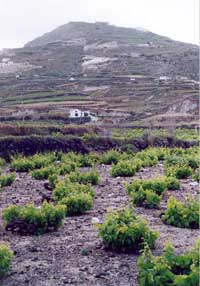 |
| Vineyards of Pyrgos |
Not far from Pyrgos, near the crater rim, SantoWines.
, the oldest, strictly quality-oriented cooperative in Greece, has settled. Since its foundation in 1947 - in the new building since 1992 - it has taken care of the marketing of the agricultural products of 14 individual cooperatives, which, in addition to wine, also produce fava beans, capers, tomatoes and sweet preserves. Of the winegrowers - about 1,000 among the 2,500 members - only half currently use their land for wine production. SantoWines President Markos Kafouros sees the preservation of the small vineyards endangered by the building boom as one of the cooperative's main tasks: "By protecting vineyards and winegrowers, we want to preserve unique cultural assets". For SantoWines, cultivating wine culture also includes using the 30 autochthonous grape varieties that still exist as a "gene bank" in order to be able to maintain traditional grape variety diversity in the future. SantoWines encourages its members to focus on quality in the vineyard. This is evident in the average yields of 3 to 3.5 t/ha of the supplier farms. Another expression of the successful, often award-winning quality orientation is the ultra-modern stainless steel equipment of the 3000-ton cellar facility in which the white musts ferment under temperature control at a maximum of 16 - 18 degrees. The proportion of white wine in the total production is 90%, about one fifth of which is exported. Expressive examples from the current range include the Vinsanto, aged for four years in barrels, and the Assyrtiko 2008, whose strong acidity, firm structure and distinctive citrus notes are due to its ageing at an altitude of 230 m to 330 metres. An Assyrtiko Reserve from 2004, aged for six months in barrique and six months in bottle, is also convincing due to its intensity, length and richness of aromas: As the noblest vine of Santorini, the Assyrtiko has just as much ageing potential as it does the gift of convincing with its freshness and complexity even as a young wine.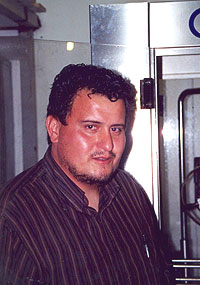 |
| Winemaker Artemis Karamolegos - Winery San...torini |
The small family winery "San...torini.
" in the small village of Exo Gonia in the middle of the island has been successfully combining modern technology with traditional vine culture since 1995. The name of the winery "San...Torini" could be translated as "like...the present one": Owner and winemaker Artemis Karamolegos wants to present his wines, vinified in a state-of-the-art winery, as refreshing ambassadors of the island's wine culture, as they are possible in the "present time". For this purpose, only the autochthonous varieties Assyrtiko, Aidani Aspro, Athiri and Mavrotagano are cultivated in the solely owned vineyards.
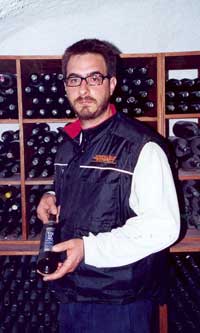 |
| The winegrower Matheos Argyros |
A few kilometres south, in the village of Episkopi Gonias Thiras in the centre of the island, lies the Argyros.
winery, one of Santorini's oldest and most renowned estates. Twice, in 2005 and 2006, the wine magazine Wine & Spirits ranked the winery, which was founded in 1903, among the 100 best wineries worldwide. The basis for this recognition was laid by Yannis Argyros, who took over the estate in 1974 as a representative of the third generation. The substantial expansion of the cultivated area to 26 ha and a modernisation of the wine cellar were accompanied by strictly quality-oriented, selective vineyard work. Recently, the winery has been run by Yannis' son Matheos, who pursues his work as an oenologist with great seriousness and precision. The basic line "Atlantis" with white, red and rosé vinification is a good entry for all those interested who expect a particularly good price-performance ratio. His young Assyrtikos, aged in steel tanks, inspire with strong acidity and fresh notes of citrus, gooseberries and green apples. In the case of the "Argyros Estate Barrel", the acidity (7.1 grams) is joined by fullness and richness of extract with notes of ripe yellow fruits, honey and nuts after ageing in new oak barrels. The Vinsanto, which only comes onto the market after twenty years of ageing, is also impressive: amber-coloured and coffee-spicy in the glass, with notes of nuts, malt and honey. Sugar (240 gr/l) and acidity (6 gr/l) find a wonderful harmony.
 |
| Winegrower Georgios Gavalas - expressive like his wines |
Only a few kilometres further southwest across the high plateau, in the middle of the tranquil village of Megalochori, the friendly and modest winemakers Georgios and Margarita Gavalas.
show how much the orientation towards tradition and precise work can lead to extraordinary results. After taking over their father's business in 1987, the Vinsanto, for example, is vinified exclusively in old 1600-litre barrels, after the grapes, including the raisins, were still pressed with bare feet. The couple feels so attached to their family's 300-year history of winegrowing that they only cultivate Santorini's traditional grape varieties on their own small area of 1.8 hectares, and the contract winegrowers who supply Gavalas only grow rare varieties such as the red Mavrotragano and Voudomato. Among the 65,000 bottles produced is an excellent cuvée of the autochthonous varieties Katsanó (85%) and Gaiduria (15%). With its fruity-earthy aromas, apple-grapefruit notes and a strong acid structure, it demonstrates what individual results the purist reflection on one's own vine tradition can produce. Those who are lucky enough to be pampered in the shady courtyard of Gavalas with the freshness of a pure Katsanó with grapefruit and ripe peach aromas and to be beguiled with a ten-year-old Assyrtiko that is fresh and acidic and exudes notes of honey, caramel and sherry, may not even want to go to the next vintner.But it is not that far to the next OPAP winery: a little further south of Megalochori, not far from the crater rim, is the "Santorini branch" of the renowned traditional winery Boutari.
. The estate, founded in 1879 in Naoussa in northern Greece, only settled on Santorini in 1988, moved into new buildings the following year and has been setting standards in the marketing of Santorini's wines not only since the planting of six hectares of its own vineyards, completed in 1994. Boutari is not only expressly committed to preserving the diversity of Greek grape varieties; with its size and its self-image based on quality, not quantity, the estate claims to have contributed to the "Greek wine revolution" in recent years.
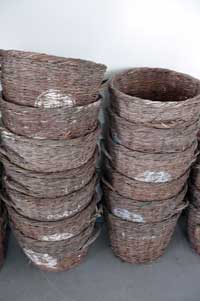 |
| The old heavy transport baskets (Boutari Winery) |
This, at least, is one of the central messages that the visitor can take from the advertising and information film in the cool circular cinema building. The oenological revolution was not only due to the wine legislation of 1971-1972, which was strictly oriented towards France, but also to Greece's accession to the European Community in 1981, which also led to considerable investments in the infrastructure of the wine industry on Santorini.
The pure Assyrtiko, but also the cuvées, are appealing for their fruitiness and freshness, to which pronounced sea salt notes can also contribute. The reserve wines with barrel fermentation, barrel ageing and daily bâtonnage.
In the north of the island - in Oia - lies the winery of the internationally renowned winemaker Paris Sigalas
. After studying mathematics at the Sorbonne, logic and mathematics were focal points of his work for many years - both as a secondary school teacher in Piraeus and later as a mathematics lecturer on Santorini. After returning to the island, he began to make wine as a sideline, as one might imagine a mathematician to do: With a lot of perseverance, clear conceptualisation, hypotheses and purposeful experiments. When he finally took over the estate founded by his parents in 1991, however, his life was no longer determined by academic dealings with logical buildings of thought. Sigalas now understood his work as a movement away from logic and mathematics, "towards the earth". The world had previously "dwindled to the contents of a box" for him, Sigalas says; only as a winemaker did the world open up to him in its magical fullness: "Le vin - c'est un miracle - the wine, that's a miracle."
 |
| Paris Sigalas |
It is no surprise that Sigalas is one of the few Santorini winemakers to practise the cup-shaped Guyot training for part of his vines. In Sigalas' estate, just outside the entrance to the tasting room, the dead-straight, purposefully irrigated rows stand as an example of Sigalas' love of experimentation. The experimental arrangement again suits the trained mathematician, for whom the yield of scattered bushes and baskets seems insufficient and not controllable enough. According to him, the postponement of the harvest to August has already proved successful in order to obtain wines with a pronounced fresh acidity.
Among the impressive results of his passion for the borderline between mathematics and nature are the Assyrtiko, aged in wooden barrels and exuding notes of yellow fruit and honey, or the powerful red Mavrotragano, aged in steel tanks, which is almost lavishly beguiling with aromas of cherries, pepper and paprika. Finally, his flagship, the elegant orange-gold Vinsanto from 2003, is rich and complex.
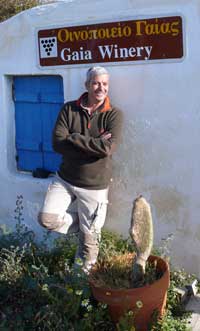 |
| Oenologist Yannis Paraskevopoulus from the Gaia winery |
GAIA W.
ines, a joint project of agronomist Leon Karatsalos and oenologist Yannis Paraskevopoulos, is unconventional, modern but more traditional than Paris Sigalas. The estate's headquarters are in Nemea (Peloponnese), where top-class wines have been produced since 1994. The wines pressed in a former tomato factory on Santorini's east coast, on the beach between Kamari and Monolithos, are excellent examples of Santorini's outstanding position in the Greek quality offensive. Already the first bottling of "Thalassitis" - a white wine from 100% Assyrtiko - indicated the Bordeaux-trained winemaker's claim to compose bone-dry terroir wines from autochthonous vines, which, thanks to a fully ripe vintage, can convince with aromatic fullness and flavour intensity with refreshing acidity. "He who comes from the sea", as "Thalassitis" is translated, presents itself in its oak-aged version as a fruitful encounter of tradition and modernity, of Greek wine history and French-inspired technology. The first must of the Assyrtiko, which flows off without pressure, is first filled into new barriques made of Nevers oak (80%) and acacia. After fermentation, the wine matures for five to six months in the same barrels, with regular bâtonnage. The result is a powerful, rich, long-lasting wine that harmoniously combines fresh citrus aromas with smoky notes.
 |
| White chapel with blue dome - popular photo motif |
Tzatziki, mouzaka and retsina - and beyond?
The quality of Santorini's wines, which is still little known in many places, illuminates a general problem of the Greek wine scene. The preconception that Greece does not have much more to offer apart from simple sweet wines and Retsina still applies to its perception, at least in Germany. Even in Greek gastronomy, a representative selection of the new Greek wine style is rarely offered - undoubtedly a problem of marketing, which still too rarely associates restaurateurs, winegrowers and restaurant visitors with modernity and lightness, but instead with folklore-like facets of tourist brochure advertising.
George Koutsoyiannopoulos is one of the winemakers on Santorini who want to break new ground here. "Unfortunately, people abroad only know tzatziki, mousaka and retsina, but we have a lot more to offer. But it is very difficult to raise awareness among consumers and producers alike. Our marketing should make it more clear how excellently our wines can serve as accompaniments to sophisticated gourmet food," he says. For lovers of Santorini's wines, it is to be hoped that the OPAP winegrowers will succeed in securing their vineyards despite the construction boom and the low yields, so that more and more vineyards are not lost for new buildings in the tourism industry.
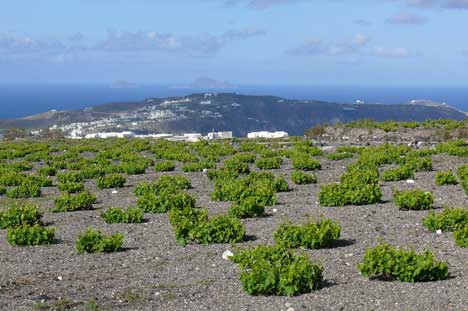 |
| Anarchy on the vineyards of Hatzidakis |
How to get to Santorini
In summer, there are many direct charter flights from German airports to Santorini. However, most of them leave only once a week, which requires booking well in advance. The easiest way is to fly via Athens. Aegean Airlines, which cooperates with Lufthansa, takes visitors from many major German (Berlin, Frankfurt, Munich, Düsseldorf, Stuttgart) and European cities to Athens and from there to Santorini. In summer, it offers up to four daily connecting flights from Athens to Santorini.
A somewhat time-consuming but at the same time inexpensive and also impressive journey is by ferry from Piraeus to Santorini. In summer there are up to seven ferry connections daily. With the high-speed boats, the crossing takes about 4.5 hours, with the regular ferry it takes about 8.5 hours. A one-way ticket costs around EUR 50.
 |
| Lava stone walls (pezoules) for the terraced grounds in the plateaus (Hatzidakis). |
Recommended hotels and restaurants visited by us.
Volcano View Hotel and Villas
Manager: Andreas Patiniotis
P.O. Box 86
Fira, 84700 Santorini
Tel.: 30 22860 24870
fax: 30 22860 24890
email: info@volcano-view.com
www.volcanoview.info
Selene Restaurant
Contact person: Yiorgos Hatziyannakis
Fira, 84700 santorin
phone: +30 22860 22249
fax: +30 22860 24395
email: selenegr@otenet.gr
www.selene.gr
Restaurant Marmita
Contact person: Andreas
Megalochori, 84700 Santorini
Phone: +30 22860 81603
fax: +30 22860 81603
email: info@marmita.com.gr
www.marmita.com.gr
Saltsa Restaurant
Contact person: Lilian Riga
Imerovigli, 84700 Santorini
Phone: +30 22860 28018
fax: +30 22860 28017
email: info@saltsa.gr
www.saltsa.gr
Restaurant Nichteri
Contact person: Vassilis Zacharakis
Kamari, 84700 Santorini
phone: +30 22860 33480
email: nichteri@nichteri.gr
www.nichteri.gr
Saltsa Restaurant
Contact person: Stavros Sigalas
Oia, 84700 Santorini
Phone: +30 22860 71362
Fax: +30 22860 71569
Recommended literature:
|
| The OPAP winemakers of Santorini | |
| GAIA Wines |
Yiannis Paraskevopoulos and Leon Karatsalos, tel: +30 210 8055642, fax: +30 210 8055542, gaiawine@otenet.gr, www.gaia-wines.gr |
|
San...torini |
San...Torini Winery, Exo Gonia, 84700 Santorini., Tel: +30 22860 33395, Fax:. +30 22860 33240. san_torini@yahoo.gr |
|
Argyros |
Estate Argyros Winery, Episkopi, 84700 Santorini, Tel: +30 22860 31489, margiros@otenet.gr, www.argyrosestate.de |
|
Hatzidakis |
Haridimos and Konstantina Hatzidakis, Pyrgos Kallistis / 84701 Santorini, Tel. +30 22860 32466 Fax +30 22860 28395, hatzidakis@hatzidakiswines.gr, www.hatzidakiswines.gr |
|
SantoWines |
SantoWines, Association Cooperatives of Theraic Products, Pyrgos, 84700 Santorini, Tel +30 22860-22596 www.santowines.gr,info@santowines.gr |
|
Boutari Winery, Megalochori, 84700 Santorini Tel: +30 22860 81011, Fax: +30 22860 81606. E-mail: santorini.winery@boutari.gr, www.boutari.gr |
|
|
Gavalas Winery |
Georgios and Margarita Gavalas, Megalochori, 84700 Santorini, Tel/Fax: +30 22860 82552, www.gavalaswines.gr,info@gavalaswines.gr |
|
Domaine Sigalas S.A., Oia, 84702 Santorini, Tel: +30 22860 71644, Fax: +30 22860 71645, www.sigalas-wine.com, info@sigalas-wine.com |
|
|
Volcan Wines |
George Koutsoyannopoulos Winery & Wine Museum, Kamari, 84700 Santorini (on the road to Kamari towards the coast), Tel +30 22860 31322, Fax - +30 22860 31355, www.volcanwines.gr,info@volcanwines.gr |
<tdSources of supply</td
| Wines of the wineries: | |
| Fischhaus Feinkost Gebr. Nikolaou GmbH Hessenstr. 90 40549 Düsseldorf-Heerdt Tel.: 0211-95603800 Fax: 0211-5048258 E-mail: info@nikolaou.org www.hellas-shop.com |
|
| Greek wine mail order Scheyernplatz 3 85298 Scheyern Tel.: 08441-8590912 Fax: 08441-85909013 E-mail: info@griechischer-weinversand.de www.griechischer-weinversand.de |
|
| Wine shop 'Cava Schustehrusstr. 20 10585 Berlin Tel.: 030-3420368 Fax: 030-34787092 E-mail: cava-tziolis@symposio.com www.symposio.com/weinhandlung |
|
| Heinz Hein - Wine trade Hofäckerstr. 7 65207 Wiesbaden Tel.: 06127-968212 Fax: 06127-66279 E-mail: info@viva-vinum.de www.viva-vinum.de |
|
| Cava Oinos Gartenstr. 101 60596 Frankfurt Tel.: 069-96360808 Fax: 069-69719709 |
|
| Atlas Food Ltd. Simon Bolivar Str. 53 28197 Bremen Tel.: 0421-394440 Fax: 0421-394442 E-mail: info@atlas-food.de |
|
| Mövenpick Wine Ltd. Martenerstr. 525 44379 Dortmund Tel.: 0231-9651560 Fax: 0231-96515633 E-mail: info@moevenpick-wein.de www.moevenpick-wein.de |
|
| Koutsoyiannopoulos Winery, Volcan Wines and Gavalas Winery | |